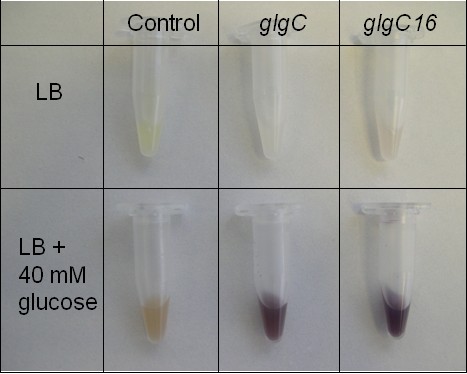Team:Edinburgh/Results/Glycogen2
From 2008.igem.org
< Previous Assay | Back to Results | Next Assay >
Contents |
Glycogen Assay 2
Background and Aims
This assay was designed to determine qualitatively the effects of our glgC and glgC16 BioBricksTM on glycogen synthesis. glgC encodes ADP-glucose pyrophosphorylase, which is responsible for the rate-limiting step in glycogen synthesis. Hence, we hypothesised that cells transformed with glgC or glgC16 BioBricksTM would produce more glycogen than control cells since glgC would be overexpressed. glgC16 is a version of glgC containing a mutation which renders it resistant to feedback inhibition, so it is expected to have the highest activity. Finally, cells should produce more glycogen when grown in a glucose-rich medium.
Procedure (3~4 Oct 2008)
- A lac promoter was added to the glgC and glgC16 BioBricksTM.
- JM109 E. coli cells were transformed with...
- BBa_K118019: lac promoter + glgC BioBrickTM.
- BBa_K118020: lac promoter + glgC16 BioBrickTM.
- Control: cells containing pSB1A2 with a non-coding BioBrickTM not expected to have any effect on glycogen production.
- Cells were grown overnight in LB and LB+40mM glucose. In all cases, ampicillin (100 mg/l) and IPTG (90 mg/l) were included, and growth was at 37 C with shaking.
- Cells were harvested by centrifugation from 1 ml of culture and resuspended in 0.1 ml of iodine reagent (5 mM I2 and 5 mM NaI in water) to test glycogen levels. Cells containing more glycogen would stain a darker brown than cells containing less glycogen.
Results
Results of the assay were as follows:
These results confirm that:
- Overexpression of glgC and glgC16 resulted in enhanced glycogen production, especially when cells are grown in a glucose-rich medium.
- It is not obvious in the photo above, but cells overexpressing glgC16 stained darker than cells overexpressing unmutated glgC, indicating that the mutation increased glycogen production.
 "
"

